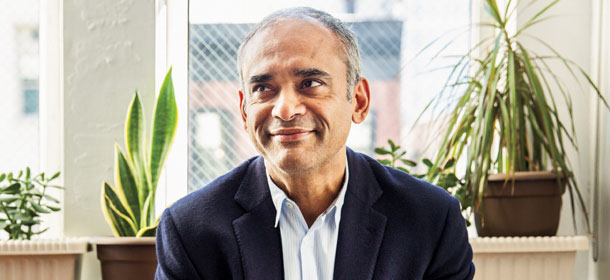Tech News
Aereo CEO: ‘We’re on the Side of the Angels’


The ratings are in. Americans love TV–and they hate their cable providers with the white-hot intensity of a thousand suns. Gripes ranging from annual price hikes to technical snafus to restrictive bundled packages continue to relegate cable companies to the cellar of consumer experience surveys: In a study by research firm Temkin Group that ranks the customer service of 235 companies in 19 industries, TV service providers occupy six of the seven bottom spots.
Chet Kanojia feels subscribers’ pain. “Media consumption is changing and evolving, but there hasn’t been a whole lot of technological progress and innovation around the cable customer experience and around billing,” he says. “Consumers feel like they’re still stuck in an era where they’re not being heard.”
Aereo, the startup Kanojia launched in 2012 in New York City, turns the conventional broadcast model on its head by enabling consumers to stream live and time-shifted TV programs to internet-connected devices–no boxes, cable subscriptions or complex wires required. The firm assigns each user a dime-size remote antenna and cloud-based digital video recorder, billing $8 per month for 20 hours of DVR space. For an additional $4 per month, Aereo customers can upgrade to 60 hours of space and the flexibility of recording two shows at once.
“Our ambition as a company is offering a better way for people to consume television and media,” says the soft-spoken Kanojia, Aereo’s CEO. “We’re getting a lot of positive reaction because we’re enabling an alternative. There is a vacuum in the marketplace that the incumbents aren’t coming in to serve.”
As of press time, Aereo services were limited to a dozen major U.S. cities, with grab-bag programming lineups determined by which signals are available in each market. But despite Aereo’s relatively small scale, major broadcasters are mounting an all-out offensive to neutralize the threat it poses. Almost immediately after Aereo went live, a consortium of TV giants filed an injunction against the service, including CBS, Disney’s ABC, Fox and NBC, whose parent Comcast will have even more skin in the game if its bid to acquire Time Warner Cable is successful. The networks contend that Aereo, which doesn’t pay for the over-the-air broadcast signals its solution captures, violates copyright law and essentially steals their programming. (The broadcasters declined to comment on the recommendation of counsel.)
Aereo is winning the battle, at least so far. In mid-2012, a U.S. District Judge denied the networks’ joint injunction, citing as precedent the landmark 2008 case The Cartoon Network v. CSC Holdings, Inc. (aka Cablevision), which determined the legality of cloud-based streaming and DVR-based services. The networks appealed the decision to the U.S. Court of Appeals for the Second Circuit, which in April 2013 upheld the lower court’s ruling and stated that Aereo’s one-to-one streaming technology is not tantamount to a public performance and therefore does not constitute copyright infringement.
Last October, the broadcasters petitioned the U.S. Supreme Court to take up the case. One month later, both the National Football League and Major League Baseball filed a joint amicus brief in support of their broadcasting partners, with the two leagues even threatening to shift their games from free TV to premium cable, “where Aereo-like services cannot hijack and exploit their programming without authorization.” The Supreme Court agreed to hear the case; a ruling is expected by the end of June.
“I’m not an attorney, but I can tell you that Aereo has gone to extraordinary lengths to craft a service that, to my eyes, stays within the law and what is decided fair use,” says Colin Dixon, principal analyst at Silicon Valley analysis firm nScreenMedia. “This is a very, very important case, because if the justices find [that Aereo’s streaming service] is a broadcast, it calls into question the Cablevision decision. It will also call into question other cloud services, as well as all infrastructure for delivery of all media over the internet.”

Chaitanya “Chet” Kanojia has spent the better part of his life dreaming up technologies with the potential to change the TV industry. As a teen in Bhopal, India, he began his entrepreneurial career building bookshelf speakers in his parents’ garage, selling them for less than the price of name-brand gear. He also hatched a never-realized scheme for a primitive video-on-demand system employing VCRs. “I tried to convince my mom to give me the money to start that. Wisely, she said no,” the 43-year-old chuckles.
Kanojia drew formative inspiration from computing pioneers like Bill Gates and Steve Jobs. “The most attractive part is that they weren’t born into it. They went from two guys in a garage to empires,” he says. “India is a pretty brutal place. There’s a lot of poverty and a lot of feral dogs running around. My father and I would go out for walks, and he would always say, ‘You know, that dog can feed himself. The challenge in life isn’t feeding yourself. What’s important is what you create.'”
After earning his bachelor’s degree in mechanical engineering from the National Institute of Technology in Bhopal, Kanojia immigrated to the U.S., attaining a master’s degree in computer systems engineering from Northeastern University in Boston. From there he joined Product Genesis, a strategic innovation management services firm spun out of the Massachusetts Institute of Technology. “That’s where I learned about product development–how you manage the process, how you allocate resources and all sorts of other skills,” Kanojia recalls.
That experience proved instrumental when Kanojia founded Navic Networks in 1999. The Waltham, Mass.-based business’s software helped cable companies with issues like spectrum planning and viewer measurement, which aided them in infrastructure management as well as rolling out targeted campaigns. Navic raised roughly $43 million from investors including Pequot Ventures (now FirstMark Capital), Himalaya Capital, Highland Capital Partners and Pilot House Ventures before Microsoft acquired the business in 2008, forking over between $200 million and $300 million, according to reports.
Kanojia stayed with Microsoft for just over two years but itched to return to the startup space, eventually discussing the Aereo concept with FirstMark managing director Amish Jani. “I remember the dialogue vividly,” Jani says. “Chet said, ‘I’ve got this idea. I’ve tried to shake it. It’s so crazy, but it’s so elegant, and I think it can be a game-changer.’ We would have backed almost anything he came up with because we thought so highly of him, but we spent a lot of time working through it and basically decided this thing was crazy enough that it just might work.”

Working with Joe Lipowski, who became Aereo’s CTO, and a team of software and hardware engineers, Kanojia began designing the remote antenna at the core of his solution, completing a functional prototype in 2011. The team next tackled how to transcode MPEG-2 on ATSC to the H.264 internet video standard at wire speed on a consumer-by-consumer basis, a challenge that stretched another six months. In all, Aereo spent roughly $50 million on R&D, finally becoming commercially available in September 2012.
While Aereo engineers toiled away, Kanojia visited every network broadcaster and many cable companies to discuss the venture. “We told them what we intended to do,” he says. “We said, ‘We think we’re right about this stuff. If you’ve got an issue, we should talk about it, and maybe we can come to a resolution.’ Not a single person said, ‘We have a problem with this.'”
Kanojia publicly unveiled Aereo in February 2012, buoyed by $20 million in financing from backers including FirstMark, Highland Capital and IAC, the media and internet company led by Hollywood power broker Barry Diller, who spent close to a decade as Fox chairman and CEO. The networks filed their injunction just two weeks later.
A source familiar with the case says that broadcasters fear Aereo could undermine the lucrative retransmission fee structure imposed by 1992’s Cable Television Consumer Protection and Competition Act, which requires cable providers to reimburse networks for carrying their content. Retransmission fees generated an estimated $3.3 billion in broadcaster revenue in 2013, a total research firm SNL Kagan projects will increase to $7.6 billion by 2019. The networks don’t just object to Aereo redistributing their programming while circumventing those fees; they believe cable and satellite operators could follow Aereo’s lead, causing a seismic shift that would endanger their bottom line.
“In some respects, Aereo actually helps broadcasters,” nScreenMedia’s Dixon counters. “One aspect of their business is advertising sales, and Aereo increases eyeballs. It’s that simple. The problem is that broadcasters are also getting a substantial amount of cash from pay-TV operators. The broadcasters are not scared of Aereo per se; it’s the approach. Because if that approach is OK, then potentially pay-TV operators could say, ‘We’re just going to do Aereo for our local broadcast stations, and we’re not going to pay [the networks] anymore.'”
The case now before the Supreme Court, American Broadcasting Companies, Inc. v. Aereo, Inc., isn’t simply about Aereo and its broadcaster opponents. A decision to block Aereo could jeopardize the cloud-computing and cloud-storage segment as a whole, potentially blocking consumers from saving and accessing content via digital locker services like Apple’s iCloud, Amazon Cloud Player and Google Play Music.
“People confuse the issue and say, ‘Aereo doesn’t pay for content,'” Kanojia says. “Well, the consumer has the right to that content for free, using an antenna. That’s what Congress said. That was the deal with broadcasters. The cloud [is] the real fight. If you stop Aereo, you’re basically saying that every time you move a file from location A to location B, you have to pay a performance tax on it. This is not limited to performances, either–it also applies to e-books and everything else across the board.”
If the Supreme Court rules against Aereo, the justices would effectively overturn the 2008 Cablevision decision and make cloud-based DVRs illegal, “in which case we have to change that architecture and revert back to putting DVRs in people’s homes,” Dixon explains. “Then I start to really worry about cloud storage for consumers. The ability for me to rip a CD, put that content on a cloud-storage device and listen to it on my iPad or smartphone when I’m wandering around–that behavior may be in question.”
And if the Supreme Court rules in Aereo’s favor? 21st Century Fox president and COO Chase Carey will consider transitioning Fox to a subscription service, and other networks could follow suit. Dixon says that scenario would likely take a long time to play out, however, citing a multitude of contractual hurdles.
“Maybe nothing happens,” Dixon adds. “One of the broadcasters’ fears is that pay-TV systems will use Aereo’s structure to avoid paying them license fees. The problem with that scenario for pay-TV providers is that NBC, CBS and Fox provide a lot of additional cable channels for those systems as well. They could say, ‘Be careful–if you do this, I’m going to pull all of my channels from your service.'” (This is not an idle threat: Time Warner Cable lost a record 306,000 subscribers in the third quarter of 2013 following a monthlong skirmish that blacked out CBS and CBS-owned cable outlets Showtime, the Smithsonian Channel and CBS Sports.)
Only the Supreme Court knows what comes next. For now, Aereo must play the waiting game. The company plans to expand to additional U.S. markets by the end of 2014; Kanojia is also plotting new features and enhancements. While Aereo has not yet revealed subscriber totals or revenue, investors remain bullish on the company’s prospects: In early January the firm closed a Series C financing round of $34 million, bringing its total funding to close to $100 million.
Kanojia says he can’t–scratch that, won’t–envision a scenario in which Aereo does not prevail. “I wouldn’t get out of bed if I was thinking along those lines,” he says. “Consumers want this, the system will be better, and we are bringing innovation into the industry. We’re on the side of the angels.”
source:http://www.entrepreneur.com/article/232285

